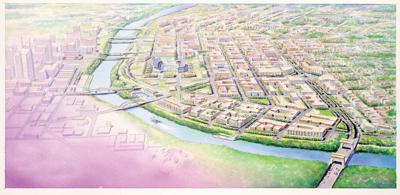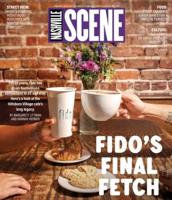Thirty years ago, Scene writer Christine Kreyling trained her attention on one downtown boulevard that looked, to her, like a huge mistake. City planners had proposed a massive arterial road in part to service a new downtown arena. Kreyling, along with other urban-design-minded locals, saw the city’s precious urban core facing an existential moment.
“The reason for the Franklin corridor was essentially to speed traffic through downtown,” Kreyling, who now lives in California, tells the Scene. “Rather than leaving an urban world down there, they wanted to put an interstate through SoBro — suburban logic applied to an urban context. We used to laugh at the fact that the fastest way to get from East Nashville to Vanderbilt was to cut right through the center of downtown because there was less traffic than the interstates.”
Suburban logic had guided Nashville under Jeff Browning, then director of city planning, who Kreyling says “spent his time planning subdivisions” and barred his planners from attending the Urban Design Forums she and others convened to debate and discuss Nashville’s urban design. They promoted walkability and dense, thriving neighborhoods that resembled the city life many attendees had experienced in New England and Europe.
The conflicting visions mirrored a larger shift in American life playing out across the nation’s younger cities. Many had grown up in the automobile age and sprawled outward, divesting from inner cities in favor of suburban-seeking white flight. At the turn of the century, lower costs of living and the enduring vibrance of city life had started to generate interest in dense neighborhoods, again stretching social and economic fabric amid the urban reinvestment that played out in the 2000s and 2010s.
One East Bank planning decision has shown Metro’s limited tolerance for public participation
“We were advocating for a different logic,” Kreyling says. “Multimodal transportation, sidewalks, small-scale commercial businesses that you could walk to. That’s what we wanted to see more of, and that’s what we were debating.”
The year was 1995, but a major decision over Nashville’s East Bank has renewed a nearly identical debate in 2025. The same summer Kreyling returns to Nashville to commemorate 30 years since the tug-of-war over what is now Korean Veterans Boulevard — and 20 years since she laid out a new city design logic in 2005’s The Plan of Nashville: Avenues to a Great City — history is rhyming, pitting urban design principles against accommodating as many cars as possible. The anniversary highlights the essential need for rich public dialogue around residents’ shared vision for the city’s future.
Kreyling will commemorate the book’s 20th anniversary at a special Frist Art Museum panel on July 10, appearing alongside Metro planner Joni Williams, Civic Design Center co-founder and former board member Seab Tuck, and current Civic Design Center CEO Gary Gaston. The panel coincides with the Frist’s special exhibit on The Plan of Nashville, which opened July 4 and runs to Dec. 14 in the Conte Community Arts Gallery.
The popular Urban Design Forums eventually became the Nashville Civic Design Center, which more recently became the Civic Design Center, a small but mighty nonprofit focused on building Nashville into a good city. The center has presided over the major political, demographic, economic and sociological shifts that have followed Nashville’s journey from an overlooked regional hub for business and education to a wealthy national hot spot driven by tourism and entertainment. Yet the fundamentals in Kreyling’s 2005 Plan still prove true and prescient. They present a mapped-and-planned vision for the modern qualities of life sought by much of Nashville’s booming population, slate of new businesses and flourishing civic character.
Urban design has also become a fixation within progressive politics. Walking, biking and public transportation have more widely been understood in recent years in terms of economic equity. Housing affordability ranks as a top issue for voters, especially in urban areas, translating bureaucratic matters of zoning and housing density into hot-button political issues. Thomas (Freddie) O’Connell is among the names listed in The Plan of Nashville’s inside cover; his commitment to so-called New Urbanism helped win over key constituencies in his 2023 mayoral campaign, just as a vision for a revitalized downtown helped Bill Purcell win the mayor’s office in 1999. Purcell, a longtime East Nashville fixture, penned the book’s introduction and was an early Urban Design Forum enthusiast.
Today, Mayor O’Connell’s Planning Department is crosswise with the city’s design community over its apparent preference for an East Bank Boulevard that includes an extra car lane rather than protected bike lanes.
“ It’s kind of bizarre the parallels between KVB and the East Bank Boulevard,” says Eric Hoke, design director at the Civic Design Center. “We’re rooted in car culture, and it takes a long time for a paradigm shift, especially in the built environment. The Planning Department says this should be a very walkable, livable, pedestrian-forward, multimodal neighborhood, so it’s kind of funny that the very first big design decision they come out with is an auto-oriented plan. We’re emphasizing this topic pretty heavily, because we know it’s an important moment to influence design decisions that will pave the way for the future.”






